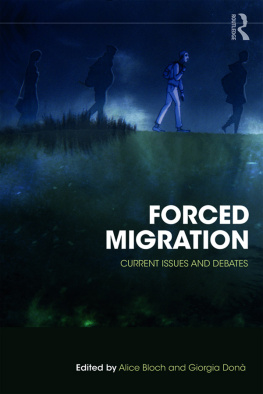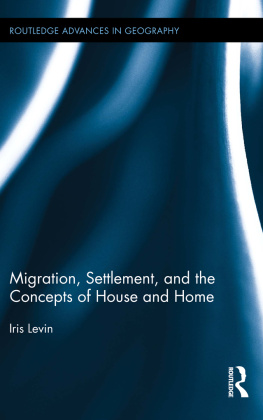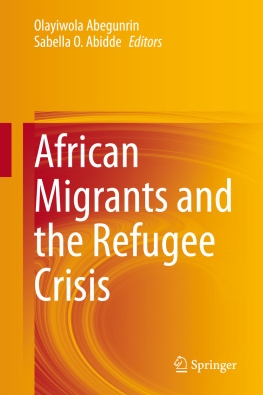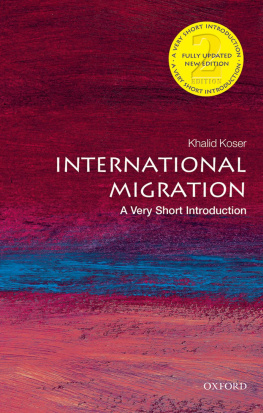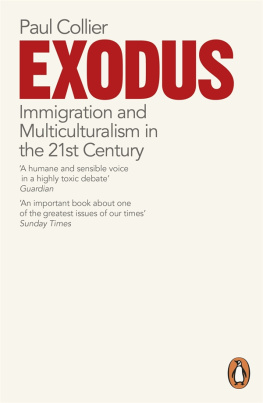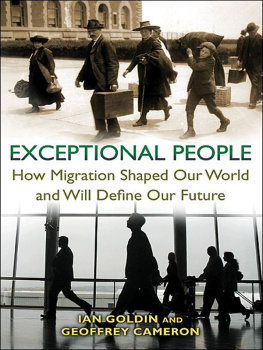Mass Migration in the World-System: Past, Present, and Future
MASS MIGRATION IN THE WORLD-SYSTEM: PAST, PRESENT, AND FUTURE
edited by
Terry-Ann Jones and Eric Mielants
Political Economy of the World-System Annuals, Volume XXXI
Immanuel Wallerstein, Series Editor
First published 2010 by Paradigm Publishers
Published 2016 by Routledge
2 Park Square, Milton Park, Abingdon, Oxon OX14 4RN
711 Third Avenue, New York, NY 10017, USA
Routledge is an imprint of the Taylor & Francis Group, an informa business
Copyright 2010, Taylor & Francis.
All rights reserved. No part of this book may be reprinted or reproduced or utilised in any form or by any electronic, mechanical, or other means, now known or hereafter invented, including photocopying and recording, or in any information storage or retrieval system, without permission in writing from the publishers.
Notice:
Product or corporate names may be trademarks or registered trademarks, and are used only for identification and explanation without intent to infringe.
Library of Congress Cataloging-in-Publication Data
Mass migration in the world-system : past, present, and future / Terry-Ann
Jones & Eric Mielants (eds.).
p. cm.(Political economy of the world-system annuals series; v. 31)
Includes bibliographical references.
ISBN 978-1-59451-813-3 (hbk. : alk. paper)
ISBN 978-1-59451-814-0 (paperback : alk. paper)
1. Emigration and immigrationEconomic aspects. 2. Emigration and immigrationSocial aspects. 3. Emigration and immigrationPolitical aspects. I. Jones, Terry-Ann, 1977 II. Mielants, Eric.
JV6217.M37 2010
304.8dc22
2009036151
Designed and Typeset by Straight Creek Bookmakers.
ISBN 13 : 978-1-59451-813-3 (hbk)
ISBN 13 : 978-1-59451-814-0 (pbk)
CONTENTS
Terry-Ann Jones and Eric Mielants
Immanuel Wallerstein
Thomas D. Hall and P. Nick Kardulias
Manuela Boatc
Rafael Reuveny
Salimah Valiani
Kathleen C. Schwartzman
K Ravi Raman
Ganesh Trichur
Lars Hansson
Mnica Ibez Angulo
Carina A. Bandhauer
Dana Diminescu and Mathieu Renault
Terry-Ann Jones and Eric Mielants
A range of theoretical approaches have been used in migration research, many of them overlapping. Although there is apparent consensus that these theories do not operate exclusively, the different approaches are clearly rooted in distinct disciplines and offer useful as well as varying analytical frameworks for the study of human migration. These paradigms tend to be complementary rather than mutually exclusive; yet, their uses vary depending on the geographic, temporal, and disciplinary contexts. Over the last couple of decades several models have proven themselves to be dominant to the field of study. Among these prevailing approaches are neoclassical economics, new economics of migration, segmented labor market, and world-systems approach (cf. Hammar et al. 1997).
The neoclassical economics approach to international migration is grounded in the assumption that there is an abundance of labor in developing countries, which produce emigrants, and an abundance of capital in developed countries, which receive immigrants. The supposition is that migrants are rational actors whose objective is to improve their opportunities for upward socioeconomic mobility, and consequently, their standards of living. This assumption, however, is one of the main critiques of the neoclassical model. Migration, even when voluntary, is not necessarily a self-motivated, rational decision or act. The new economics of migration compensates for this limitation of the neoclassical economics approach.
The new economics of migration is similar to the neoclassical economics approach in its notion that there are global economic disparities that motivate people to migrate as a means to attaining their socioeconomic potential. However, this approach differs in that it does not only consider the individual as the rational decision maker. Instead, the nuclear or the extended family is engaged in the decision making process, as they also share both the costs and the benefits of migration. This involvement of other members of the family or household minimizes the risks associated with migration, as both resources and duties (child care, for example) are shared (Massey et al. 1993).
The segmented or dual labor market approach to migration posits that there is a division in the global labor market that results in the labeling of certain jobs as migrant jobs. Occupations such as domestic and agricultural work, for example, often receive a majority of foreign-born workers, particularly in the main migrant-receiving countries such as the United States and Canada. This model differs from the neoclassical and new economics of migration approaches in its macro-level approach. While the former two models are based on the premise of individual or family/household decisions, the latter supposes that international migration is the product of labor demands in receiving countries (Massey et al. 1993; Piore 1979). Nonetheless, wage differentials in the context of an asymmetrical labor market alone do not explain sustained labor flows over long periods of time, and the new economics of migration often neglects to scrutinize a broader social and political context over more prolonged periods of time (Portes 2007:7576). Expanding the unit of analysis in terms of geography as well as temporality (e.g., McKeown 2004; Hatton and Williamson 2008) is a more difficult, but necessary endeavor if social scientists attempt to analyze the phenomenon of mass migration in all of its complexity. More recently, a new field of transnational migration studies has emerged (see Levitt and Jaworksy 2007) to challenge the more traditional and static models of migration and assimilation that focus on the process of unidirectional mobility from sending to host society and incorporation as a process that encompasses the host society exclusively. Transnationalism, although not without its critics (e.g.,Waldinger 2008), has opened up a new field of study, if not paradigm, to scrutinize immigrants multidirectional interactions between their respective countries of origin and countries of arrival as well as the circulation of capital, money, material goods, ideologies, symbols, and political projects that the migration process conveys under conditions of capitalist expansion in an unequal and hierarchical international system (Grosfoguel, Cervantes-Rodriguez, and Mielants 2009:10).1
Situated at an even higher level of abstraction (Portes 2007:76), is the world-systems approach to international migration, which cannot be separated from its analytical focus on global economic disparities (e.g., Mielants 2002). The theoretical foundation for the approach can be found in Immanuel Wallersteins (1974; 2004) thesis that capitalism is a specific socioeconomic system, characterized by a global division of labor resulting from intense, yet unequal, bulk trade linkages between different zones, which he labeled core, periphery, and semiperiphery. This capitalist world-system emerged in sixteenth-century Europe and subsequently expanded to incorporate more areas. In the context of the colonialism and imperialism that unfolded from 1492 until the early twentieth century, the entire world became interlinked through these trade patterns constitutive of unequal exchange. By stressing the importance of economic cycles and commodity chains of leading sectors, Wallerstein and other world-system theorists espoused the idea that the upward and downward social mobility of specific polities was possible. Arguing against the modernization or developmentalist school, dominant in the 1960s, which assumed that every country could achieve upward social mobility as long as it implemented the correct policies, they claimed that the growth of world trade does not alter the fact that it is essentially a polarizing zero-sum game, reproducing and expanding poverty and inequality on a world scale. The crucial concept of semiperiphery was introduced to clarify this idea theoretically: the three zones in which different political entities such as nation-states are located, contain divergent practices (in terms of life expectancy, standard of living, labor control, production of items for sale on the world market, and political regimes) precisely because of their hierarchical location within the capitalist world-economy.


